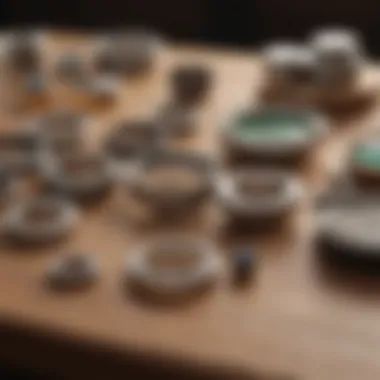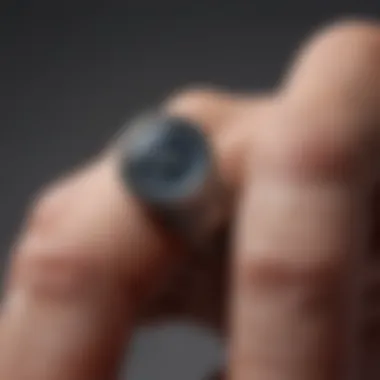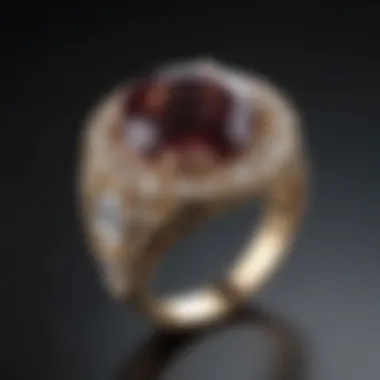Determining Your Ring Size: A Comprehensive Guide


Intro
Finding the perfect ring size can be a perplexing task, whether you're purchasing an engagement ring, a family heirloom, or merely a sparkly addition to your personal collection. Many people face the struggle of determining their size accurately, often leading to confusion and dissatisfaction with their purchase. The common methods might seem deceptively simple, yet they can yield surprising inaccuracies.
This guide aims to peel back the layers on how to determine your ring size. We won’t just focus on measuring techniques; we will delve into the underlying importance of ring sizes, the tools you’ll need, and even tips to keep in mind during your shopping journey. The aim is to equip readers—be it novices or seasoned collectors—with an arsenal of knowledge for a smoother, more informed experience when it comes to selecting the right ring.
Expect the unexpected as we unravel this often-neglected aspect of jewelry design, steering clear of generic declarations and instead focusing on substantial, actionable insights. Let’s journey through this world of measurements and preferences, ensuring every ring you buy not only dazzles but also fits like a glove.
Understanding Ring Sizes
Grasping the concept of ring sizes is essential for anyone considering the purchase of jewelry. It might seem trivial, but knowing how to determine your exact ring size can save you from a world of hassle, especially when shopping for significant items like engagement rings or heirlooms that you'll treasure for a lifetime. An incorrect size can lead to discomfort or even loss of a beloved piece. In this section, we’ll delve into the nuances of ring sizes, offering a deeper understanding that will facilitate better buying decisions.
What Is a Ring Size?
At its core, a ring size is a numerical value that corresponds to the circumference of your finger. This one measurement is pivotal, as it dictates how snugly or loosely a ring will fit.
In the United States, ring sizes generally range from 3 to 13, with half sizes available for more precise fitting. For context, a size 7 ring has a circumference of approximately 54.4 mm. Other countries employ different measurement systems, leading to conversions that can baffle even the most seasoned jewelry lovers.
The takeaway? Understanding what ring size really means removes the ambiguity associated with purchasing rings. An educated buyer can sift through options with confidence, knowing they’ve chosen the right fit for their needs.
Importance of Knowing Your Ring Size
Knowing your ring size isn’t just about convenience; it can profoundly impact your relationship with jewelry. When you wear a ring that fits just right, you enjoy it without the constant worry of it slipping off or feeling too tight.
Here’s why it matters:
- Comfort: A well-fitted ring will sit comfortably on your finger without causing painful pinching or unsightly bulging.
- Aesthetics: A ring that’s too large may spin around your finger, obscuring its design. Conversely, a small ring can lead to visible discomfort and detract from the beauty.
- Longevity: Rings that fit snugly are less likely to get damaged or lost, protecting your investment.
In short, being aware of your correct ring size can lead to greater enjoyment and appreciation of your jewelry.
Common Ring Size Measurements
When it comes to measuring, there are a few standard approaches that jewelers and manufacturers use. The most common measurements include:
- US Sizing: As mentioned, this is a straightforward numerical system.
- UK Sizing: This uses letters, where ring sizes range from A to Z (and beyond).
- European Sizing: Primarily measured in millimeters, showing the inner circumference.
Each system has its quirks, but commonly sizes can be converted with a simple chart. Here’s a brief overview:
- US Size 6 ≈ UK Size M
- US Size 7 ≈ EU Size 54
- US Size 8 ≈ UK Size Q
This understanding empowers you to navigate international jewelry markets comfortably, ensuring that wherever you are in the world, you can find your ideal fit.
Measuring Your Ring Size at Home
Knowing your ring size doesn’t have to be a hassle. In fact, measuring at home offers flexibility and simplicity. If you’re in the market for a new ring or you simply want to ensure that your collection fits perfectly, getting this measurement accurately is crucial. Home methods can save you time and reduce the risk of miscommunication with jewelers who might use different sizing standards. Also, it can be particularly useful if you're caught between sizes, allowing you to experiment without breaking the bank.
Using a Ring Sizer
A ring sizer is a handy tool designed specifically for determining your finger size. It often comes in the form of a plastic or metal set of rings. Simply slip each ring on until you find the one that snugly fits your finger. The beauty of this method lies in its convenience; you can do this while lounging on your sofa or sipping a cup of tea.
Rather than guessing, a ring sizer provides an accurate reading without the guesswork. Just remember to measure at the end of the day when your fingers have reached their maximum size. Depending on the temperature or other conditions, your actual size can vary.


String or Paper Method
If you don’t have a ring sizer handy, the string or paper method can come to your rescue. This method is both straightforward and widely accessible. Here’s how to do it:
- Take a piece of string or strip of paper about 6 inches long.
- Wrap it around the base of your finger, making sure it's snug but not tight.
- Mark where the string or paper overlaps.
- Unwrap it and lay it flat, then measure the length to the mark with a ruler.
- Use the measurements against a ring size chart to find your size.
This method is precise, but ensure that you don’t pull too hard. It’s a delicate balance—you want it snug, but you also want to avoid cutting off circulation.
Measurement with a Caliper
For those inclined to be a bit more technical, using a caliper could be an excellent option. A caliper can provide highly accurate measurements. Here’s the process:
- Obtain a digital caliper. These tools are usually found at hardware stores or online.
- Ensure the caliper is zeroed out before you start.
- Gently close the caliper around the inside diameter of a ring that fits well, or around the base of your finger for direct measurement.
- Read the measurement. Most calipers display measurements in both millimeters and inches, which can then be converted to ring sizes using a conversion chart.
Using a caliper delivers precision, allowing you to gain insights that other methods might miss. It could be particularly beneficial for those who are serious collectors or jewelers, where every millimeter counts.
Proper ring size measureing can save you from future resizing costs.
In summary, these at-home methods cater to various preferences and situations. Whether you employ a ring sizer, the string or paper method, or opt for a precise caliper, knowing your size before making a purchase is indispensable. Expect accuracy while making purchases, and remember: a ring should embody comfort and style.
Factors Affecting Ring Size
When it comes to selecting the right ring size, it isn’t just a straightforward number. A multitude of factors plays a vital role in determining how a ring will fit on your finger. Understanding these factors can save you from future discomfort and embarrassment. Ring size isn’t just about the digits; it’s about how it feels, how it moves, and how it complements your lifestyle. Let’s dive into some of the most significant influences on ring size.
Temperature Variations
It might sound odd, but temperature can significantly affect your finger size. On a chilly day, your fingers tend to shrink, making a ring fit tighter than it would on a warm day. Conversely, warm weather or even a heated environment can cause your fingers to swell, resulting in a looser fit. If you’re considering purchasing a ring, it's smart to try it on at a time when your fingers are at a typical comfortable temperature.
Time of Day Influence
Another less-discussed factor is the time of day. Your body goes through natural changes throughout the day - most people experience slight swelling or dilation of their fingers as a result of daily activities. Mornings tend to be when fingers are fuller because there's less movement overnight. In the afternoon or evening, after spending the day on your feet or consuming salty foods, you may notice your fingers feel puffier. This is a crucial aspect to keep in mind when measuring for a ring. Ideally, measure your ring size later in the day, when your fingers have settled.
Personal Conditions
Weight fluctuation
Weight changes can have a noticeable impact on your ring size. As your body transitions between gaining or losing weight, the fat tissue in your fingers can also fluctuate. This might not seem like a big deal until you find that a beloved ring no longer fits. If you tend to experience significant weight changes, it might be wise to keep this in mind if you're on the hunt for a new ring. An effective method is to regularly check your ring size if you're aware of changes in your weight, which helps prevent being caught off guard.
Swelling
Swelling in your fingers can be due to various reasons, including exercise or even heat. If you’ve engaged in physical activity, such as working out, your fingers may swell slightly due to water retention or increased blood circulation. Keep an eye on how your fingers feel on such days—it's crucial to account for this when determining your size. You wouldn't want to get a size that feels good just after a workout only to discover that it becomes uncomfortable afterward.
Health issues
Certain health concerns can also lead to variations in finger size. Conditions like arthritis or other inflammatory diseases can cause your fingers to swell, making it necessary to size up. If you’ve experienced any health changes recently, it’s a good idea to assess how these could impact ring sizing, particularly if you’ve had a recent diagnosis or treatment.
"Being informed about these aspects is crucial. It’s not just about fitting; it’s about comfort and enjoyment in wearing your jewelry."
Understanding these elements can be incredibly beneficial when purchasing a ring. You want to be sure that your chosen piece brings joy, not frustration.
Using Professional Services


When it comes to determining your ring size, there’s a certain peace of mind that comes from consulting the pros. Using professional services not only brings expertise to the table but also eliminates the guesswork that can easily lead to mishaps. Here, we'll explore two primary ways you can take advantage of professional expertise in finding your ideal ring size – through jewelry store consultations and online ring size tools. Each option has its unique set of benefits, giving you the flexibility to choose what works best for your needs.
Jewelry Store Consultation
Visiting a local jewelry store for a consultation can be beneficial in a number of ways. First and foremost, experienced jewelers possess the skills and tools to measure your finger size accurately. They can also consider factors specific to your context, such as any health-related issues that might influence your ring size.
A jeweler often employs a ring mandrel, which is a tapered rod designed for size measurement. It’s both an art and a science; the jeweler slides a range of rings over your finger to figure out just the right fit or uses a specialized sizer that won’t irritate your skin.
Moreover, this face-to-face interaction enables you to discuss preferences and styles that might affect sizing. For example:
- The width of the band: Wider bands may need a slightly larger size for comfort.
- Gemstone settings: Some settings can add bulk, affecting the perceived size.
- Your lifestyle: If you engage in activities that involve heavy lifting or fluctuating temperatures, the jeweler can provide tailored advice.
In short, a jewelry store consultation is a hands-on approach that provides clarity, reassurance, and an opportunity to build a rapport with jewelry professionals, turning what might feel like a daunting task into a pleasant experience.
Online Ring Size Tools
If you prefer a more DIY approach or can’t make it to a jewelry store right away, there are numerous online ring size tools that can guide you through the measurement process. These tools are designed with user-friendliness in mind, making it easy to gauge your size from the comfort of your home.
Many websites provide printable guides, where you can place an existing ring over the printed circle to check its size. Alternatively, there are digital sizers that allow you to measure your finger directly using a mobile app. The benefits of these tools are plentiful:
- Convenience: Measure your size at any time without the need for travel.
- Privacy: Some may prefer to keep the sizing process personal, avoiding discussions with a jeweler.
- Variety of Resources: Many online tools come with tips and tricks to ensure accurate measurements.
"In the age of technology, why not combine convenient access with accurate sizing?"
However, one must be cautious and ensure they’re using reputable sources to avoid discrepancies. Always double-check the instructions provided, as accuracy is paramount when it comes to ring sizing.
Combining professional services in-store and online can offer a comprehensive approach to finding your perfect ring size. Whether you opt for face-to-face expert guidance or tech-savvy tools, knowing your ring size with confidence ensures that your next piece of jewelry fits like a dream.
Converting Ring Sizes
When it comes to purchasing rings, understanding ring sizes becomes crucial, especially in a global market where various countries employ distinct sizing systems. Converting ring sizes isn't just a matter of fitting; it impacts comfort, aesthetics, and potentially the value of the jewelry as you consider your choices. Whether you’re ordering a piece from a distant artisan or gifting to a friend overseas, accuracy in size conversion is your ally.
International Size Conversion Charts
Navigating through international size charts can feel like deciphering a foreign language. Different regions embrace specific measurements, leaving many puzzled when it’s time to buy a ring from abroad. Common systems include the US, UK, European, and Japanese sizing. For instance, a US size 7 might correspond to a UK size N 1/2 or a European size 54. Understanding these conversions can save you from discomfort while wearing a new purchase.
Key Points to Consider:
- US Sizes are typically referenced as whole and half sizes, ranging from size 3 to 16.
- UK Sizes employ letters, where N is often considered average.
- European Sizes use a more straightforward numerical system that directly relates to the internal circumference of the ring in millimeters, which might be more intuitive.
- Japanese Sizes follow a similar numerical pattern to the European system, being useful for seamless cross-referencing.
As you delve into these charts, remember that while they provide a guideline, actual fit can still vary based on the design and style of the ring.
"Knowledge is power, especially when it comes to ensuring your ring fits like a glove."
Understanding Different Measurement Systems
Diving deeper into measurement systems, it's essential to be aware that not only are sizes different, but the way they are measured can vary. Manufacturer standards can result in slight discrepancies even within the same country, creating headaches for the unprepared. Some countries might measure the inner circumference in metric units, while others may focus on the diameter.
To further compound this, there are sometimes specific sizing conventions based on the ring's width, which can affect comfort and fit. A wider band may often feel tighter compared to a slimmer one; hence, this is a factor worth keeping in mind when considering rings from different regions.
Things to Keep in Mind:


- The Width Influence: A broader band can lead you to choose a larger size to avoid uncomfortable constriction around your finger.
- Material Matters: Certain metals expand and contract in different temperatures, potentially impacting how a ring feels on your hand.
- Comfort or Fashion: This decision can sway sizing choice—some prefer a snug fit for security, while others lean toward a looser style for comfort.
Getting acquainted with these varying systems and nuances enables you to navigate through a world of ring buying with greater confidence. When you understand ring sizes and how they adapt across borders, your journey turns smoother.
Troubleshooting Common Ring Sizing Issues
Understanding how to handle ring sizing dilemmas is crucial to ensure that your cherished pieces fit comfortably and securely. Often, individuals face challenges when their ring does not fit as expected, leading to frustration or even the need to resize. These common issues can arise due to various factors, including weight fluctuation, changing seasons, or simple miscalculation during measuring. Addressing these problems not only enhances your wearing experience but also prolongs the longevity of your jewelry.
Determining the Right Size After Weight Gain or Loss
Changes in body weight can greatly affect ring size. For instance, after a diet or through weight gain, a ring that once fit snugly may suddenly feel tight or too loose. The ring's fit can change as much as one or two sizes, depending on the extent of the weight change. To determine the right size post-weight fluctuation, consider the following steps:
- Measure Again: Use one of the methods discussed earlier, such as the string method or a ring sizer.
- Assess Finger Conditions: Keep an eye on temperature or hydration levels, as these can alter the size of your fingers.
- Trial with Different Rings: If available, try rings in the suspected new size to gauge comfort.
A ring that is too tight can cause discomfort and even restrict blood flow. On the other hand, a loose ring might slip off when you least expect it. Therefore, your best bet is to be proactive and adjust your size as needed after any significant weight change.
When to Resize Your Ring
Knowing when to resize your ring is essential for both comfort and wearability. Here are some indications that your ring may need resizing:
- Persistent Discomfort: If your ring is consistently uncomfortable, it's a sign you should reassess its size.
- Rings Spinning on Finger: A ring that rotates around your finger may be too large.
- Difficulty Taking Off the Ring: If removing your ring becomes a challenge, it could indicate a size too small.
It's advisable to consult with a jeweler if you notice any of these symptoms. They can provide exact sizing and recommend the best options for resizing, ensuring your jewelry looks as good as it feels.
Dealing with Ring Stuck on Finger
Getting a ring stuck on your finger is a nerve-wracking experience but can typically be solved without too much fuss. If you find yourself in this situation, here are some methods to safely remove the ring:
- Lubrication: Apply soap, lotion, or oil around the finger and ring. Carefully wiggle the ring while applying the lubricant.
- Cold Water: If swelling is causing the issue, briefly immerse your hand in cold water. This can help reduce swelling and may loosen the ring's grip.
- Medical Assistance: In extreme situations where a ring cannot be removed despite efforts, seek help from a medical professional who is experienced in this sort of thing.
It’s vital to act calmly and avoid pulling too hard, as this may cause injury.
Being attentive to these common sizing issues not only improves the overall experience of wearing rings but also helps maintain their beauty and functionality. Keeping them in a perfect fit ensures that your jewelry remains an enjoyable part of your life.
Ending
Determining your ring size is more than just a number; it’s a reflection of personal style, comfort, and choice. The significance of understanding your ring size cannot be overstated. Imagine receiving a gift or purchasing a piece that doesn’t fit, leaving you with disappointment instead of joy. Knowing your size eliminates these frustrations and leads to more informed decisions, whether you’re buying for yourself or someone special.
In this guide, we’ve delved into various methods for finding the right fit, discussing simple at-home techniques alongside professional solutions. Each method brings its own advantages, from the convenience of measuring at home to getting accurate results at a jeweler. The knowledge of how factors like temperature and time of day can affect sizing adds another layer of insight that can prove useful.
Key Elements to Keep in Mind:
- Accuracy is Key: Measuring correctly ensures a snug fit.
- Consider Lifestyle: Your daily activities may influence size preferences.
- Understanding Swelling or Changes: Being aware of how external factors can alter ring size helps in choosing a versatile fit.
With this knowledge, you are better equipped to navigate the jewelry world, avoiding common pitfalls. Whether it’s a significant occasion, like an engagement, or simply a personal treat, being aware of your ring size ensures that every piece you own fits just right, thus enhancing the overall experience.
Final Thoughts on Determining Ring Size
As we wrap this up, remember that finding the right ring size isn’t a one-off task. It changes with life’s ebbs and flows. Regularly checking your size, especially after major life changes will help keep your collection aligned with your current self. Connection to the jewelry you wear can deepen when it fits perfectly, making every piece more significant.
Further Resources for Gemstone Enthusiasts
For those looking to expand their knowledge further, consider visiting the following resources:
These platforms offer a wealth of information about gems and jewelry, where you can learn more about the nuances of size, materials, and styles. Engaging with a community of enthusiasts can provide insights and advice that are both practical and enriching. In the end, remember that wearing a ring isn’t just about its appearance; it’s about how it resonates with you personally.







